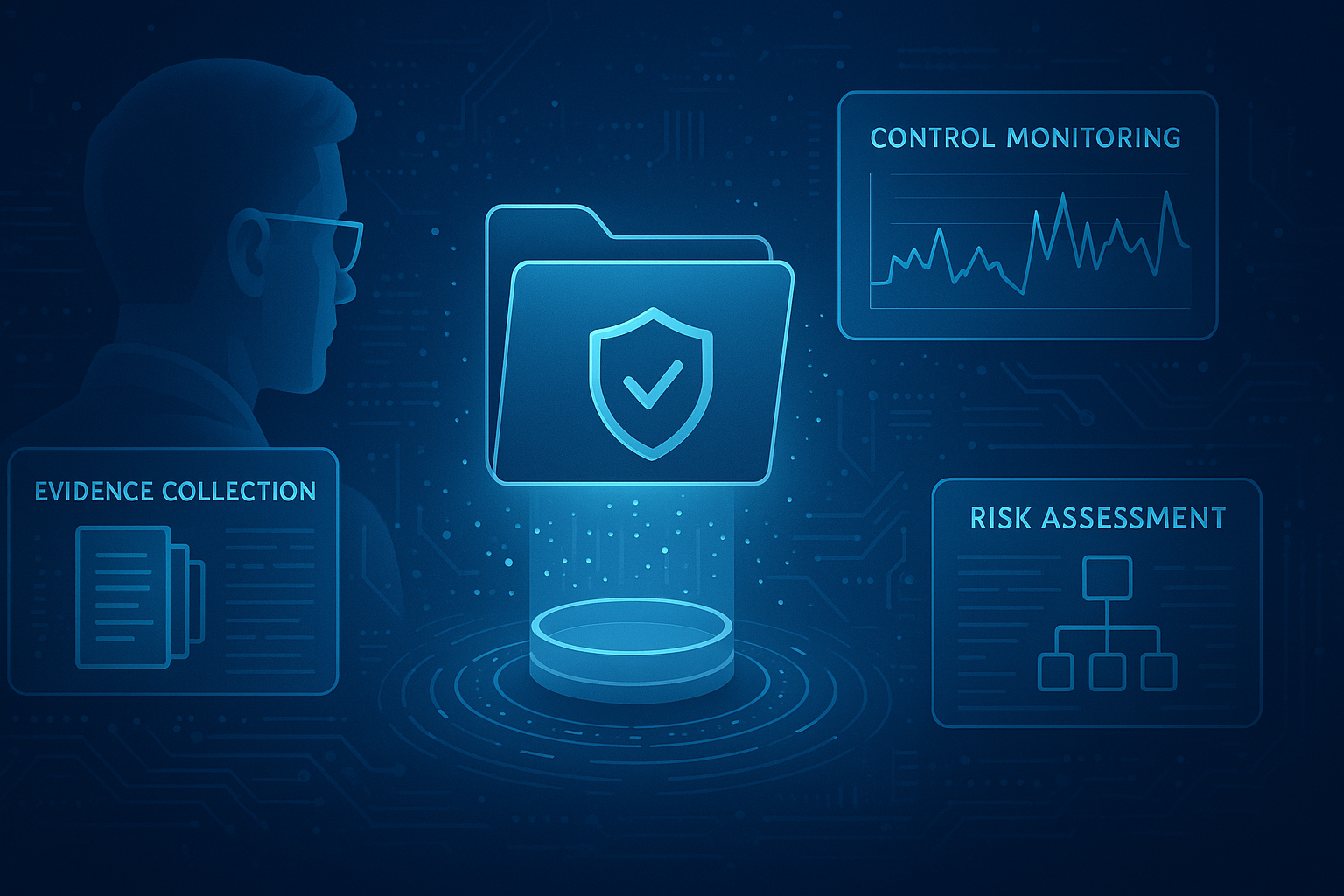Automated cyber risk assessment tools help you assess information security risks and related metrics in real-time based on the available internal and external data. Connecting the dots makes the bigger picture visible to management to see what's going on. This is exactly what these tools do.
Read to learn about the top five automated risk assessment tools for information security programs. However, before moving on to that, we must discuss why we need to examine these cyber risk quantification tools.
What About Legacy GRC Systems?
Before the advent of automated risk management tools, legacy GRC tools were used to manage cyber and data security measures.
This term refers to a system, technology, software, or component that requires an update. Often, traditional technologies are integral to an organization's functioning, as multiple processes and departments utilize them.
Riverbed Technology recently surveyed 1,000 business and technology leaders worldwide, revealing that 97 percent believe legacy technology hinders their progress. Despite the digital business era, most organizations, from SMBs to large enterprises, still rely on legacy applications to protect information security. These businesses also utilize legacy technology to protect network security, cloud security, and infrastructure security, all of which contribute to the weakness of the information security program.
Some main reasons why so many large companies are beginning to see it as an unviable option are:
- Increasingly high operational costs and downtime
- Security vulnerabilities
- Diminished talent pool
This is where automation tools come in. Security professionals and Chief Information Security Officers (CISOs) should review these top five automated risk assessment tools and how they help solve these problems.
Exploring Cyber Risk Assessment Automation Tools
Workflow Automation (Including Ticketing Integration)
Identifying and evaluating potential risks is essential for the risk assessment workflow. The process involves determining their likelihood of occurrence and assessing their likely impact on the project. Risk is inherent in all projects. Dealing with the uncertainty associated with project delivery is crucial to protecting the project's value.
Consequently, a primary process associated with project management is risk assessment, which is part of the project risk management process.
It is a unique identifying number generated by a network server for each client. It can be used by the client, another network server, or the server itself as a means of authentication and proof of authorization, which cannot easily be forged.
Risk and Report Automation
Report automation is software that allows the creation and automatic updating of digital marketing reports. Combining regular emails with automatic data gathering enables the delivery of gathered data to specific email addresses regularly.
You might be wondering what this means for the C-suite. The C-suite must actively identify opportunities and risks to successfully leverage advanced technologies applied through intelligent automation. They must be aware of the impact of intelligent automation on the company's overall culture, processes, and, most importantly, its people.
Continuous Control Monitoring
Continuous Control Monitoring (CCM) is the process of automatically and continuously evaluating the effectiveness of security and compliance controls using real-time data. Rather than relying on manual, point-in-time assessments, CCM provides an ongoing, evidence-based view of whether controls are functioning as intended across the enterprise.
What Does CCM Solve For?
Traditional compliance assessments are often:
-
Manual and time-consuming
-
Outdated by the time they're complete
-
Lacking continuous validation of control effectiveness
-
Disconnected from real-world threats and vulnerabilities
CCM addresses these challenges by:
-
Automating control validation using live telemetry and system integrations
-
Providing near real-time visibility into control performance
-
Identifying control failures and drift before audits or incidents occur
-
Reducing audit fatigue and remediation delays
How CyberStrong Delivers Continuous Control Monitoring
CyberStrong’s CCM capabilities are built for real-time, scalable compliance. The platform:
-
Ingests telemetry data from cloud and on-prem systems to continuously validate control effectiveness
-
Uses AI-powered intent-based mapping to align controls across multiple frameworks with minimal manual effort
-
Offers live dashboards that show current control status, failure alerts, and trends over time
-
Powers automated evidence collection, reducing audit prep time and ensuring controls are always audit-ready
-
Correlates control performance with risk posture to inform strategic decisions and remediation planning
With CyberStrong, organizations transition from static compliance snapshots to a dynamic, proactive compliance program, ensuring that security controls are not only in place but also functioning as intended every day.
Automated Risk Tracking and Trending Risk Assessment
Tracking (risk monitoring) is a process that involves systematically monitoring and evaluating the effectiveness of risk mitigation actions against established metrics throughout the acquisition process and recommending further risk mitigation options or implementing them as necessary.
Here are some of its components:
- Risk identification
- Risk assessment
- Risk monitoring
- Risk predictions
Check out some significant benefits of risk tracking and assessment:
- Better management of organizational risk
- Discovery of new risks
Automate Cyber Risk Quantification for Clearer Insights
Risk quantification is the process of forecasting loss frequency and severity to improve decision-making and resource allocation. An organization can reduce the financial impact of loss-causing events by having reliable estimates of their likelihood translated through a financial perspective. Modern cyber risk quantification models include NIST 800-30 and the FAIR model.
Some companies complain about cyber risk quantification being too tricky. This is mainly because the topic can be confusing and derail company decision-makers. Check out some common pain points of risk quantification:
- Systems are too complex to predict
- The security ROI doesn't guarantee investment
- There could be conflicting definitions of risk
- You might not have enough data to make predictions about risk
By associating security threats and risks with a monetary value, security teams and leaders can prioritize risks and remediation processes based on historical data. Security professionals who use risk quantification are better prepared to defend against data breaches and ensure the longevity of the cybersecurity program.
Implement Automated Cyber Risk Assessment Tools for Enhanced Cyber Resilience
Modern organizations face unique challenges that require them to monitor, track, and assess their security postures in real-time to avoid data loss events.
The automated risk assessment tools detailed above decrease the need for manual intervention in those processes, delivering real, tangible ROI for your business. But if you want targeted help and reliable expertise in cyber risk management and compliance automation, check out CyberSaint.
Founded by security experts, CyberSaint delivers the only platform to connect security operations, continuous compliance, and risk management. For more information on CyberSaint solutions, request a demo, or check out our resource center for more posts like this.
FAQ: Top Automated Risk Assessment Tools
What are automated risk assessment tools?
Automated risk assessment tools are software solutions that use real-time data—both internal and external-to identify, evaluate, and quantify cybersecurity risks. These tools automate key processes like risk identification, control scoring, reporting, and continuous monitoring, helping organizations gain a clearer picture of their cyber risk posture without manual effort.
Why should organizations move away from legacy systems?
Legacy GRC systems are often expensive to maintain, prone to security vulnerabilities, and difficult to scale. Many organizations still rely on them despite the risks, but 97% of business and tech leaders say legacy technology is holding them back. Modern automated tools address these shortcomings with greater efficiency, real-time data integration, and better visibility into risk.
What capabilities should I look for in top automated risk assessment tools?
The best tools will offer:
-
Workflow and ticketing automation for seamless issue tracking
-
Control score automation through real-time data ingestion and mapping
-
Risk quantification using models like FAIR or NIST 800-30
-
Report automation for consistent, accurate updates to stakeholders
-
Risk tracking and trending to monitor and predict evolving threats
How does automation improve risk quantification?
Automated tools simplify the traditionally complex process of CRQ by converting technical risk metrics into financial terms. This allows CISOs and other security leaders to prioritize actions based on potential business impact, ensuring better decision-making and RoSI.
What are the benefits of using automated risk assessment tools?
Some of the key benefits include:
-
Real-time visibility into cyber risk
-
Reduced manual workload and human error
-
Better alignment with compliance frameworks
-
Financial modeling of risk to support executive decision-making
-
Increased agility in responding to emerging threats
How do these tools help CISOs and executive teams?
Automated risk assessment tools offer dynamic reporting, trend analysis, and financial quantification of cyber risk—all critical for C-suite alignment. These insights help CISOs effectively communicate risk posture and justify cybersecurity investments in business terms.
Is CyberSaint considered one of the top automated risk assessment tools?
Yes. CyberSaint offers CyberStrong, a comprehensive cyber risk management platform that combines cyber risk quantification, continuous control automation, and compliance management in a single solution. It's purpose-built for organizations seeking scalable, AI-powered automation in risk management and reporting.
How do I get started with an automated risk assessment platform?
Start by identifying your organization’s key pain points, whether it's a lack of visibility, manual processes, or difficulty in quantifying risk. Then, explore platforms like CyberSaint that offer a demo and educational resources to guide your transition.





.png)
.png)
.png)
%201.png)
.png)




